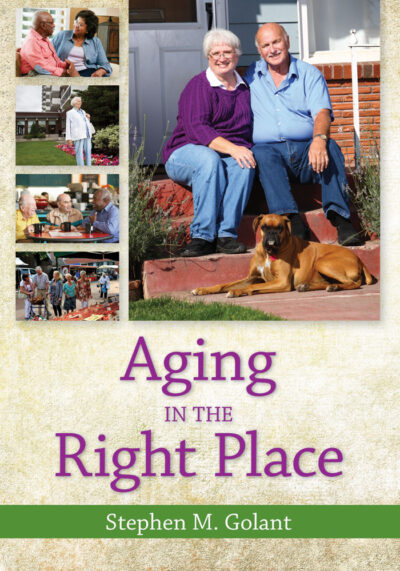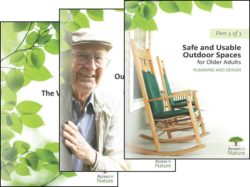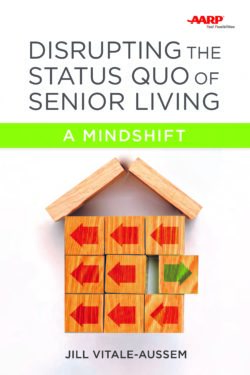Product Description
Encouraging new ways to look at the question of how to grow old successfully, Aging in the Right Place highlights the profound significance of where older people live and receive care. This book explores many pathways to thriving in old age, ranging from aging in place to moving to housing and care settings specially tailored to match a person’s lifestyle and vulnerabilities.
A thorough overview of available residential options and care settings for aging adults provides the backdrop for a deeper discussion of the often overlooked emotional challenges individuals face because of changes in their health, mobility, finances, marital status, and communities. Author Stephen Golant, Ph.D., introduces a new framework of “residential normalcy” to help understand how older adults feel about these changes and effectively cope with the problems of where they live.
Expansive in its coverage, Aging in the Right Place examines the current role of family assistance, private sector initiatives, and government programs along with the future potential of smart home technologies and innovative housing, planning, and long-term care solutions. Additionally, this comprehensive resource
- paints a vibrant picture of the diverse experiences of today’s older adults
- abounds with engaging and illustrative case studies, opinions, stories, and quotes
- presents a new model for understanding the challenging balance between meeting the sometimes conflicting need for emotional comfort in a setting, but also physical competence and a sense of control
- offers 10 key takeaways on the importance of environment in determining whether older people age successfully
- identifies housing and care topics that need further research, reform, support, and public awareness
Written by a gerontologist with decades of professional experience in the field as well as personal experience as a family caregiver, this exceptional and cohesive text is essential for gerontology, long-term care, healthcare, housing, planning, and public service professionals, practitioners, and academics.


 Stephen M. Golant, Ph.D., is professor at the University of Florida (Gainesville) and previously was associate professor at the University of Chicago. He has been conducting research on the housing, mobility, transportation, and long-term care needs of older adult populations for most of his academic career.
Dr. Golant is a Fellow of the Gerontological Society of America and a Fulbright Senior Scholar award recipient. In 2012, he received the Richard M. Kalish award from the Gerontological Society of America in recognition of his insightful and innovative publications on aging and life development in the behavioral and social sciences. Print and Web-based media have often featured in his research and ideas and he has appeared on numerous television and radio programs, including ABC’s national news program 20/20.
Dr. Golant has written or edited more than 140 papers and books, including Location and Environment of Elderly Populations (Wiley, 1979); A Place to Grow Old: The Meaning of Environment in Old Age (Columbia University Press, 1984); Housing America’s Elderly: Many Possibilities, Few Choices (Sage Publications; 1992); The Columbia Retirement Handbook (Columbia University Press, 1994); Encyclopedia of Financial Gerontology (Greenwood Press, 1996); the CASERA Report (Creating Affordable and Supportive Elder Renter Alternatives) (Margaret Lynn Duggar & Associates, Inc., 1999); and The Assisted Living Residence: A Vision for the Future (The Johns Hopkins University Press, 2008).
Dr. Golant serves on the editorial boards of The Gerontologist, Journal of Aging Studies, CSA Journal (Society of Certified Senior Advisors), Journal of Housing for the Elderly, Research on Aging, and Seniors Housing & Care Journal.
Dr. Golant is frequently called on by corporations, universities, state government agencies, and national organizations as a lecturer or an adviser. He also served as a consultant to the Congressionally appointed Commission on Affordable Housing and Health Facility Needs for Seniors in the 21st Century (Seniors Commission), a bipartisan 14-member panel created by an act of Congress to study the housing and healthcare needs for the next generation of elderly Americans and to offer specific policy and legislative recommendations to the U.S. House of Representatives and the U.S. Senate.
Stephen M. Golant, Ph.D., is professor at the University of Florida (Gainesville) and previously was associate professor at the University of Chicago. He has been conducting research on the housing, mobility, transportation, and long-term care needs of older adult populations for most of his academic career.
Dr. Golant is a Fellow of the Gerontological Society of America and a Fulbright Senior Scholar award recipient. In 2012, he received the Richard M. Kalish award from the Gerontological Society of America in recognition of his insightful and innovative publications on aging and life development in the behavioral and social sciences. Print and Web-based media have often featured in his research and ideas and he has appeared on numerous television and radio programs, including ABC’s national news program 20/20.
Dr. Golant has written or edited more than 140 papers and books, including Location and Environment of Elderly Populations (Wiley, 1979); A Place to Grow Old: The Meaning of Environment in Old Age (Columbia University Press, 1984); Housing America’s Elderly: Many Possibilities, Few Choices (Sage Publications; 1992); The Columbia Retirement Handbook (Columbia University Press, 1994); Encyclopedia of Financial Gerontology (Greenwood Press, 1996); the CASERA Report (Creating Affordable and Supportive Elder Renter Alternatives) (Margaret Lynn Duggar & Associates, Inc., 1999); and The Assisted Living Residence: A Vision for the Future (The Johns Hopkins University Press, 2008).
Dr. Golant serves on the editorial boards of The Gerontologist, Journal of Aging Studies, CSA Journal (Society of Certified Senior Advisors), Journal of Housing for the Elderly, Research on Aging, and Seniors Housing & Care Journal.
Dr. Golant is frequently called on by corporations, universities, state government agencies, and national organizations as a lecturer or an adviser. He also served as a consultant to the Congressionally appointed Commission on Affordable Housing and Health Facility Needs for Seniors in the 21st Century (Seniors Commission), a bipartisan 14-member panel created by an act of Congress to study the housing and healthcare needs for the next generation of elderly Americans and to offer specific policy and legislative recommendations to the U.S. House of Representatives and the U.S. Senate.



Administrator –
“If there’s one place to go for everything you need to know about housing and aging, it’s Stephen Golant. He brings a lifetime of deep scholarly knowledge to this book. Aging in the Right Place is the right book to go for what you need on these issues.”
—Harry R. Moody, Ph.D.
Retired Vice President, AARP
Distinguished Visiting Professor, Fielding Graduate University
Administrator –
“Professor Golant has brought a masterly, balanced account to the deceptively simple but contentious concept of ‘aging in place.’ He correctly observes that ‘place’ is the missing concept in the ‘New Gerontology’ that has a valued positive approach but risks neglect of people who continue with proactivity and meaning in their lives notwithstanding challenges as they grow older. Golant’s framework of ‘residential normalcy’ charts a sensible, rigorous path that respects diversity among older people themselves and addresses opportunities to improve the social, political and environmental worlds that shape all of our lives. This ‘must read’ book brings rigorous thought and sound evidence to constructive approaches to ageing for gerontologists, planners and health and welfare professionals, and most of all to older people themselves and their advocates.”
—Hal Kendig, MPl, Ph.D., FASSA
Professor of Ageing and Public Policy, Centre for Research in Ageing, Health, and Wellbeing, Australian National University
Administrator –
“This outstanding and important book addresses its theme ‘Aging in the Right Place’ by discussing the psychology of aging as it relates to autonomy, control, coping, adaptation and self-esteem. The context is the desire to achieve ‘residential normalcy.’ After addressing the many challenges to older adults and their families of remaining in their homes, Golant continues to draw on a strong foundation of research to describe why some older adults choose to move to age-restricted communities of varying types to achieve not only normalcy but stimulation and continued engagement. This is a must read for professionals in the field of housing and aging services.”
—Susan B. Brecht
President, Brecht Associates, Inc.
Administrator –
“Where are the best places to live in later life? According to Stephen Golant, the views of experts and the residential preferences of older Americans may not align. He argues that elders have a considerable capacity for coping with change and suiting themselves about house and home. In this informative book, Golant brings readers his deep knowledge about the great variety of places in which elders can thrive no matter their limitations. ‘There are many pathways to aging successfully,’ he writes, and many places where feelings of comfort and mastery can be achieved. [This] book is a great resource for elders, families, professionals and students”
—David J. Ekerdt, Ph.D.
Director, Gerontology Center
Professor of Sociology
University of Kansas
Administrator –
“Stephen Golant goes beyond traditional and often simplistic perspectives on the demographics of aging populations to address the foundational need for living environments that maximize quality of life. In a detailed and thoughtful manner, he recognizes not only the physical aspects of aging, but the emotional content of lives of many decades and experiences. Just as no two individuals can be the same, nor any life perfect, neither are the options for achieving residential normalcy. It is Stephen’s review of these options, both pro and con, that provide the most thorough insight to date for both older adults and the family, professionals, and organizations who care for and about them. A much needed resource for a world in which ‘Global Aging’ may be the seminal event of the 21st century.”
—Andrew Carle
Executive-in-Residence, Founding Director
Program in Senior Housing Administration
George Mason University
Administrator –
“In proposing a theory of ‘residential normalcy,’ Stephen Golant considers how complex coping strategies allow an understanding of environmental change in later life which he tests across a continuum of contexts and settings. This book is a very welcome addition to the field of environmental gerontology with international relevance for all concerned with the interaction of person and place.”
—Professor Sheila Peace, The Open University, United Kingdom
Administrator –
“This important and welcome book weaves together theory, public policy, and statistical and demographic data to explore the meaning and significance of place to older persons and their families. The question of where to live, whether to stay or move, under what circumstances, and when, is central in the lives of most older persons who fear making the wrong decision and losing their sense of identity and their community. This book explains, through an empirically-grounded conceptual model, that people just want to feel normal in the place they live, whether they remain in their current neighborhood or choose one of the carefully described housing options currently available in the United States. This book is accessible and easy to read that should be of interest to a general audience as well as to academics, housing providers, and policy makers.”
—Paula C. Carder, PhD
Associate Professor
Institute on Aging
Portland State University
Administrator –
“In his most recent book, Aging in the Right Place, Stephen Golant has brought into focus the complex, multi-layered intersections of older people and their living environment in the most refreshing and innovative monograph on this topic to date. What is most impressive is the author’s ability to explicate how the lived experience of individuals transitioning along different life courses is inextricably linked to an environmental realism rooted in theoretical synthesis, research knowledge, and real world application.”
—Andrew V. Wister, Ph.D.
Professor, Gerontology Department
Simon Fraser University at Harbour Centre
Chair, National Seniors Council of Canada
Administrator –
“Dr. Golant’s new publication has made a major contribution to our understanding of what it means to ‘age in place’ and ‘age in community’ and how we might achieve these goals. Aging in the Right Place provides a comprehensive overview of these important concepts, using the lens of environmental gerontology to examine the range of challenges and opportunities. Throughout the various chapters, he weaves in the notion of residential normalcy and how that can be achieved at the individual, family, building and community levels. Dr. Golant ties his analyses together by concluding that we need to replace the idea of ‘aging in place’ with the concept ‘aging in the best possible place’—a timely message for our aging society.”
—Robyn Stone, DrPH, Senior VP for Research, LeadingAge
Administrator –
“This is the most important, beautifully conceived, and well-written book on housing and residential alternatives for elderly populations written to date. This creative, thoughtful, and problem-focused book confirms why Dr. Stephen Golant is recognized internationally as a foremost leader in environmental gerontology. It should be required reading for all researchers, students, applied professionals, community planners, and policy-makers concerned with improving the quality of life of elders. Golant has provided a major service to gerontology in this sweeping, evidence-informed treatment of why place – both objective and experienced – is central to understanding and improving the well-being of diverse groups of older adults. It is a timely ‘pendulum-corrective’ for the New Gerontology paradigm of successful aging, which holds older adults themselves responsible for many of the problems they experience within residential settings. It usefully evaluates the current ‘aging-in-place’ mantra, showing the upside as well as the limitations it places on alternative housing options.
Golant uses his theory of residential normalcy – and the common need of older adults to experience a sense of comfort as well as mastery in one’s abode – to illustrate how and why places may no longer suit these needs and what diverse groups of elders do when this occurs. Importantly, he offers practically-oriented options that address coping, housing modifications, alternative housing options, as well as caregiver and community-level supports to achieve improved fit between the housing needs of older persons and their resources.
Psychologist Kurt Lewin once said, ‘There’s nothing so practical as a good theory.’ Golant’s book illustrates this beautifully. It succeeds because Golant’s focus doesn’t divert down intellectual rabbit holes. It is a scholarly book based on a wide array of solid evidence; at the same time, it is an inviting, interesting read because it remains practically and realistically focused on the well-being of older adults themselves. Their voices inform this book and have informed Golant’s theory from its inception. I wish I had written this book! Failing that, it provides a perfect model of translation research, one of the best produced in environmental gerontology.”
— Dr. Rick J. Scheidt
Professor
School of Family Studies and Human Services
Kansas State University
Administrator –
“Aging in the Right Place is a truly outstanding contribution to the field of gerontology and multiple related disciplines. Golant provides what is now the most comprehensive treatment of the subject of housing our aging population, describing the challenges and opportunities of relocation in later life, traditional and new housing options and the critical relationship between housing and services. The work is extremely well-referenced and clearly organized. It should reach a wide audience of researchers, students, practitioners, policy-makers and consumers… no small achievement.”
—Philip B. Stafford, Ph.D.
Indiana University
Administrator –
“[This book] gives planners what they need to move ahead with initiatives that consider the views of both experts and older people themselves…. and provides valuable background and substantive material that can help planners ask better questions, consider a broader range of options, and talk
with a wider spectrum of people than they might otherwise.”
—Journal of Planning Education and Research